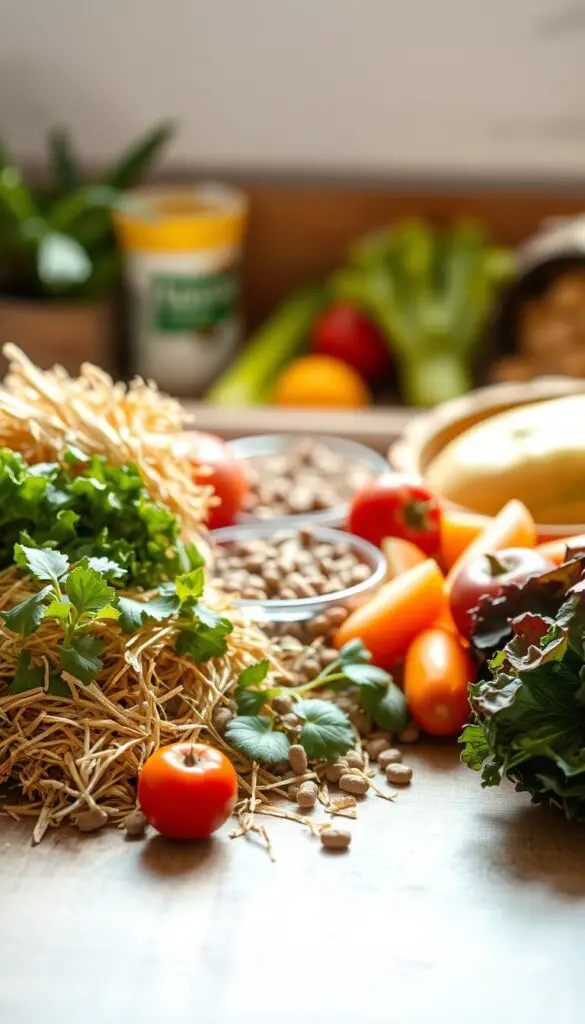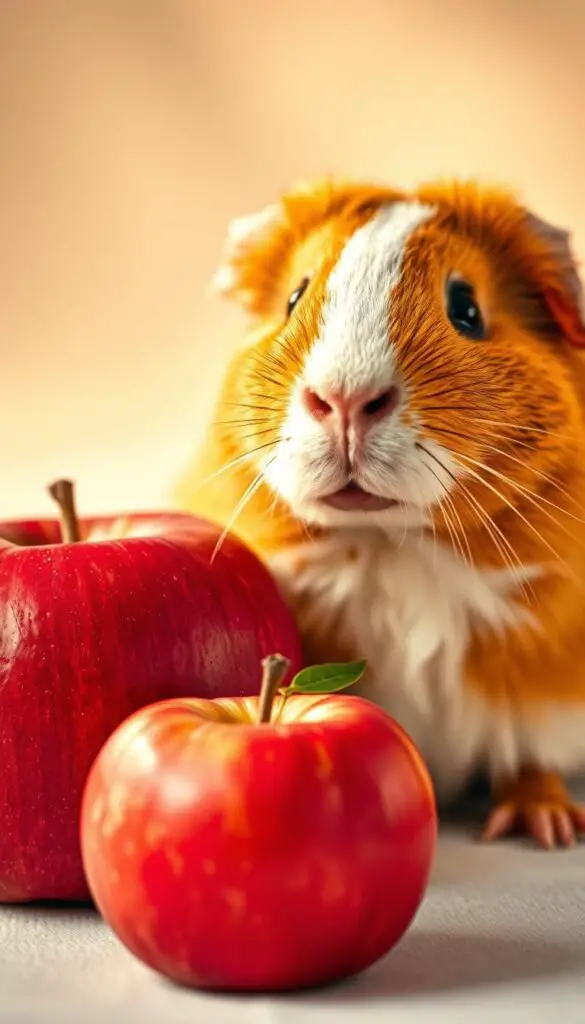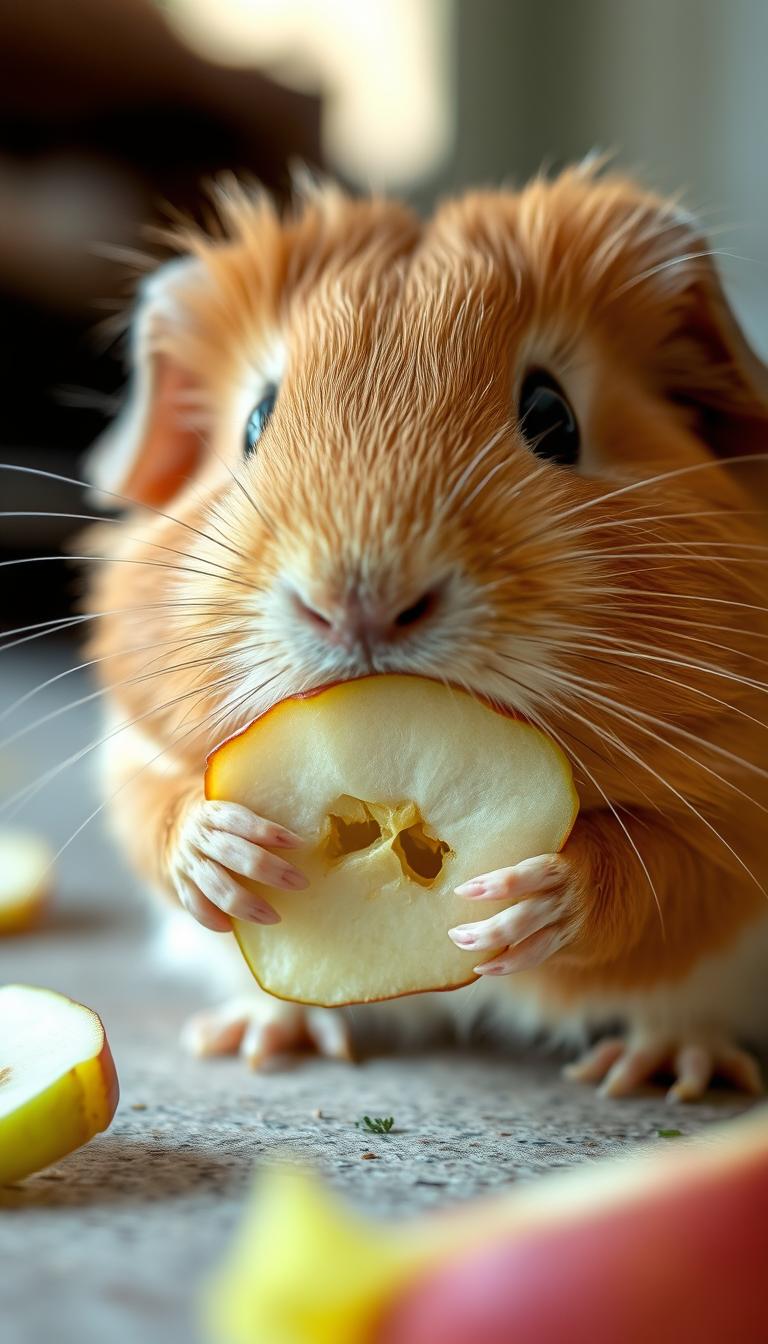If you’re wondering whether to share this crunchy treat with your furry companion, you’re in the right place. Many pet owners worry about introducing new foods, but here’s some good news: the outer layer of apples offers surprising health perks for small herbivores.
Rich in fiber and antioxidants, these natural snacks support digestion and overall wellness. While some pets might turn up their noses at the texture, the skin holds most of the fruit’s potassium and quercetin—nutrients that boost heart health and brain function.
Always rinse produce thoroughly to remove chemicals or wax. Even organic varieties need a quick scrub under water. If your pal prefers softer textures, peeling reduces nutritional value but still provides a sweet reward in moderation.
This guide will walk you through portion sizes, preparation tips, and signs to watch for during snack time. You’ll learn how to balance treats with their regular diet while keeping meals exciting and safe.
Table of Contents
Understanding Your Guinea Pig’s Nutritional Needs

Proper nutrition forms the cornerstone of your furry friend’s well-being. Unlike humans, these small companions require specific vitamins and fiber sources to thrive. Let’s explore how to build meals that keep them energetic and healthy.
Why Vitamin C Matters
Your pet’s body can’t create vitamin C naturally. Without daily intake through leafy greens or bell peppers, they risk developing scurvy. Symptoms include swollen joints and difficulty moving—issues easily prevented with proper meal planning.
Fiber’s Digestive Role
High-fiber foods maintain gut function and prevent bloating. Timothy hay should make up 80% of their meals, mimicking their wild grazing habits. Pair it with fresh vegetables to create balanced nutrition.
| Food Type | Daily Percentage | Key Benefits |
|---|---|---|
| Timothy Hay | 70-80% | Supports dental health & digestion |
| Leafy Greens | 15-20% | Provides vitamins & hydration |
| Treats | 5% max | Adds variety & mental stimulation |
Limit sugary fruits to occasional snacks. Focus on hay-first feeding to maintain their sensitive digestive systems. Rotate vegetable choices weekly to expose them to diverse nutrients without overwhelming their palate.
Benefits of Apples for Your Guinea Pig

Wondering which treats support your furry friend’s wellness? Discover apple’s hidden advantages. This fruit delivers more than sweetness—it’s loaded with elements that promote vitality in small herbivores.
Rich Nutrients and Antioxidants
A 100g serving provides 4.6mg of vitamin C, crucial for immune defense and tissue repair. Since pets can’t produce this vitamin naturally, snacks like apples become valuable supplements.
Fiber content shines at 2.4g per portion, aiding digestion and preventing overeating. Combined with B vitamins, it helps break down carbs and maintain nervous system health.
Essential minerals work behind the scenes too. Iron supports blood health, while magnesium balances sugar levels. Potassium keeps muscles functioning smoothly, and antioxidants fight cellular damage.
These components create a nutritional synergy. Offering thin slices weekly adds variety without overwhelming their diet. Remember—moderation ensures your pal reaps the rewards safely.
Can Guinea Pigs Eat Apple Skin? Key Facts

Crunchy apple skins might seem like a simple snack, but they pack a nutritional punch for small pets. While some furry friends prefer peeled slices, the outer layer holds hidden advantages worth considering.
Nutritional Perks of Leaving the Skin On
That thin outer layer delivers 60% more fiber than peeled fruit. It also contains concentrated potassium levels—essential for maintaining healthy blood pressure and muscle function.
Quercetin shines as the skin’s star antioxidant. Studies suggest this compound supports brain health by protecting nerve cells. While research focuses on humans, these potential cognitive benefits could extend to pets too.
| Nutrient | With Skin | Without Skin |
|---|---|---|
| Fiber (per 100g) | 4.4g | 1.5g |
| Potassium | 195mg | 90mg |
| Antioxidants | High | Low |
Always scrub fruit thoroughly before serving. A vinegar-water soak helps remove surface residues while preserving nutrients. If your companion rejects the texture, try grating small amounts into their greens.
Remember—balance remains key. These treats should complement a hay-based diet, not replace it. Offering skin-on slices weekly lets your pal enjoy diverse flavors while reaping natural benefits.
Preparing Apples Safely for Your Guinea Pig

Transforming fresh apples into safe snacks requires careful preparation steps. While these fruits offer nutritional value, proper handling ensures your pet enjoys them without risks. Let’s break down the best practices for creating tasty, worry-free treats.
Washing and Peeling Techniques
Start by rinsing whole fruits under cool running water. Scrub gently with a produce brush to remove dirt or chemical residues. For extra caution, soak slices in a 3:1 water-vinegar mix for 15 minutes before rinsing.
Peeling reduces pesticide exposure but removes beneficial fiber. If you choose this method, use a sharp vegetable peeler to minimize nutrient loss. Organic varieties still need washing—natural contaminants can linger on surfaces.
Proper Cutting and Serving Sizes
Slice apples into thin wedges or ¼-inch cubes. Match the size to your pet’s mouth—younger companions need smaller pieces. Always discard seeds and cores, which contain toxic compounds harmful to small animals.
| Preparation Method | Time Required | Best For |
|---|---|---|
| Diced Fresh | 5 minutes | Immediate feeding |
| Freeze-Dried | 2 hours | Long-term storage |
| Pureed | 10 minutes | Mixing with veggies |
Rotate serving styles to keep meals interesting. Freeze-dried options retain nutrients but skip added sugars. Purees work well mixed with leafy greens for picky eaters. Always provide fresh water alongside these sweet snacks.
Understanding the Risks: Apple Seeds and Cores
While apples make a tasty snack, their hidden dangers require careful handling. Tiny components within this fruit could turn a treat into trouble if overlooked. Let’s explore how to protect your companion from preventable hazards.
Choking Hazards and Cyanide Concerns
Those small, hard seeds pose dual threats. Their size and shape create choking risks, especially for enthusiastic eaters. More critically, they contain amygdalin—a compound that releases cyanide when chewed or digested.
Though one seed won’t cause immediate harm, repeated exposure allows toxins to accumulate. Veterinarians emphasize removing every seed before serving. Core areas demand extra attention since they cluster multiple seeds in tight spaces.
| Risk | Source | Prevention Tips |
|---|---|---|
| Choking | Hard seed texture | Discard core, slice thinly |
| Cyanide | Amygdalin in seeds | Remove all seeds thoroughly |
Accidentally swallowed seeds usually pass harmlessly if chewed well. However, proactive removal eliminates uncertainty. Always cut fruit away from the core’s seeded center—your vigilance ensures snack time stays joyful and safe.
Double-check each slice under bright light. Those glossy brown specks hide easily against apple flesh. Turning this step into routine care shows your commitment to their long-term health.
Feeding Guidelines: How Much Apple Should You Offer?

Balancing treats with nutrition keeps your small companion thriving. While fruits add excitement to meals, their sugar content demands careful planning. Let’s break down smart strategies for incorporating these sweet snacks responsibly.
Portion Recommendations for Treats
A ½-inch cube of apple twice weekly strikes the perfect balance. This tiny portion delivers flavor without overwhelming their system. Always remove seeds and monitor stool consistency afterward—loose droppings signal it’s time to reduce servings.
Frequency of Feeding Fruit
Natural sugars in apples accumulate quickly in small bodies. Stick to 1-2 weekly treats to prevent weight gain and digestive upset. Pair these snacks with fibrous veggies like bell peppers or cucumbers for better nutrient absorption.
Start with pea-sized pieces if introducing apples for the first time. Gradually increase to the recommended serving over 2-3 weeks. This slow approach lets their gut bacteria adjust without causing distress.
Remember: fruits should never exceed 5% of daily food intake. Most meals should focus on hay and leafy greens. Rotate apple treats with blueberries or melon slices for variety while maintaining nutritional balance.
Homemade Apple Treats and Variations
Discover how to turn fresh apples into exciting, health-boosting delights for your little friend. With a few clever twists, you can transform this common fruit into engaging snacks that support their well-being.
Creative Ways to Serve Fresh Apples
Mix diced apples with spinach or kale for a colorful salad. Add shredded carrots or cucumber slices to create texture variety. This combination delivers vitamins while keeping treat time interesting.
For pets needing softer food, simmer peeled apples in water until tender. Blend into puree without additives—ideal for older companions or those recovering from illness. Freeze small portions in ice cube trays for a cool summer snack.
| Preparation Method | Best For | Key Benefit |
|---|---|---|
| Diced Fresh | Immediate Snacking | Retains nutrients |
| Apple Salad | Meal Variety | Combines food groups |
| Applesauce | Sensitive Eaters | Easy digestion |
Avoid store-bought dried or canned options containing sugars or preservatives. Stick to fresh preparations—freeze-dried slices made at home preserve flavor without harmful additives. Always remove seeds and cores before serving any apple-based treats.
Rotate these ideas weekly to maintain your pal’s enthusiasm. Pair apple pieces with bell peppers or celery sticks for extra crunch. Remember—simple, natural preparations always win over processed food alternatives.
Exploring Alternative Fruits and Vegetables
Expanding your pet’s menu keeps meals exciting while providing essential nutrients. A colorful mix of produce offers different vitamins and textures that support overall health. Let’s explore tasty options beyond their regular favorites.
Delicious and Nutritious Choices
Berries like blueberries and strawberries make excellent occasional treats. These safe fruits provide antioxidants without excessive sugar. Melons and pears offer hydration during warmer months—just remove seeds thoroughly.
Tomatoes surprise many owners as viable options. Though technically fruits, their tangy flavor appeals to many pets. Pair them with crunchy veggies like bell peppers or zucchini for balanced snacks.
- Citrus varieties require caution—limit oranges to rare treats
- Leafy greens like endive and beet tops add daily fiber
- Steamed squash or broccoli florets introduce new textures
Always chop items into bite-sized pieces to prevent choking. Introduce one new food every 3-4 days, watching for digestive changes. This gradual approach helps identify preferences and intolerances.
Remember: fresh produce should complement—not replace—their main hay diet. For portion guidance on specific items like strawberries, consult trusted feeding charts. Rotating 2-3 different fruits and veggies weekly maintains interest while delivering diverse nutrients.
Debunking Common Myths About Guinea Pig Diets
Pet owners often hear conflicting advice about what’s safe for their furry companions. Let’s clear up confusion with science-backed truths that keep your pal healthy and happy.
Separating Fact from Fiction
One persistent myth claims these small animals develop allergies to fruits like apples. In reality, true allergies are rare. Most digestive issues stem from overfeeding or sudden diet changes—not immune responses.
While upset stomachs can occur, they usually signal intolerance to specific sugars or fibers. Start with tiny amounts when introducing new foods. Observe for 24 hours before offering more.
Another misconception suggests all fruits harm guinea pigs. In truth, many options provide vital nutrients when served properly. Focus on moderation and variety—key principles for any balanced meal plan.
Remember, every pet has unique needs. What works for one might not suit another. When in doubt, consult an exotic vet to tailor feeding strategies that match your companion’s health status and preferences.



